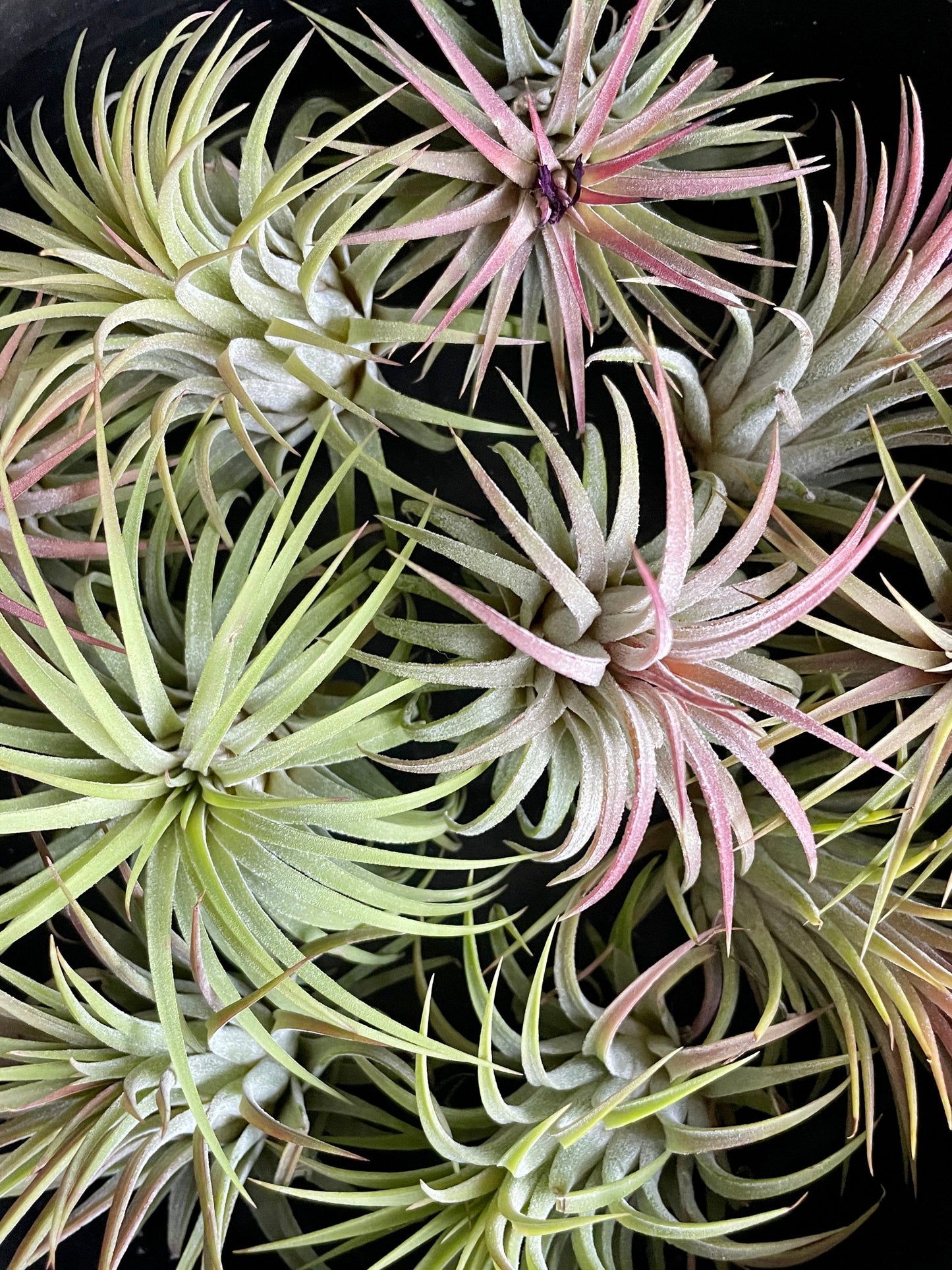
The question we hear most often is: to mist or to soak?
The answer: it really depends on your environment and where you keep air plants.
Just as the frequency and amount of water and nutrients you give your houseplants depends on your indoor environment, where your plants grow how much light they receive, the amount of humidity and the temperature are all factors in deciding what is the right method for your Tillandsia.
We have guidelines to help you along that journey!

Here are a few tips we've learned over the years to guide you to keeping your air plant healthy and growing strong:
Understanding Trichomes
Have you noticed the fuzzy layer on your air plant covering their leaves? These are called trichomes and are the reason your plant survives without soil.
Most air plants do grow roots, but instead of using their roots to gather water and nutrients, air plants use them to cling to tree branches or mountaintop cliff sides.
Instead of gathering hydration and nutrients through roots, trichomes perform the vital role of absorbing everything the air plants needs in order to survive. That's why we add a few drops of Sacred Soil Tonic to their spray bottle before misting or to their bath before soaking. You can see our favorite way to enjoy an air plant Sacred Plant Ritual here:
https://www.instagram.com/
Trichomes from Ancient Greek 'hair' are tiny appendages on plants, algae, lichens, and certain protists. Trichomes provide several vital functions: as tiny root and leaf hairs they absorb water and nutrients, they work as a protective coating to reflect radiation (built in sunblock) and also regulate plant temperature and hydration levels. Sound familiar? Trichomes are indeed similar to epicuticular waxes, the powdery layer that coats most land plants like echeveria, staghorn ferns, grapes and blueberries.
But that's not all, trichomes also serve as insect repellant too! Trichomes are amazing!

1. Where does your plant come from?
Learning where your air plant comes from is always the first and best way to understand the type of care it needs to thrive in your home. Whenever we recreate the natural environment for our house plants, we help them to grow to their fullest potential.
2. Plant Anatomy
By simply looking at the structure of your plant you can generally determine light and watering needs. Air plants with full, thick leaves like these Xerographica indicate the ability to retain moisture (think succulents) and also that it’ll handle more sun exposure.
If your air plant has full, thick leaves like those on these Xerographica, that indicates the ability to retain moisture (think succulents) and also that it’ll appreciate some sun exposure. You can mist them a few times a week if in a nicely ventilated spot or soak for 10-20 mins every few weeks if your environment is dry.
*Always be sure to flip over to dry after soaking your plant to prevent root rot!
Thin, wispy leaves indicate it prefers a shaded environment and should not be placed under direct sunlight and need more frequent hydration.

3. Light requirements
The safest place for your air plants, regardless of the type, is in a spot where it receives early morning or later afternoon/early evening sunlight. This ensures it'll get enough light while not being scorched by hot afternoon sun. Alternatively, keep your Tillandsia in a place with super bright but always indirect sunlight.
4. Water & Nutrients
Your air plant is thirsty when the leaves begin to curl inward, more hydrated leaves will appear flat and open. While misting or keeping your air plant in a humid location in your home (like the bathroom where it can soak up shower steam) is important, most air plants still need a soak in room temperature water for 20-30 mins every 10-14 days. If that isn't a possibility, be sure it receives a thorough misting a few times a week.
*IMPORTANT: Be sure there is plenty of ventilation if you are misting heavily instead of soaking as the root area of the air plant needs to dry out properly. Think of its native environment of subtropical forests or mountaintops where they enjoy a breeze. After soaking, it’s very important to flip your plant upside down for an hour or so to ensure the water isn’t pooling up in the root area.
The best water for air plants (all plants really) is the kind without chemicals! We encourage you to use rain, well, or spring water whenever possible or, if your municipal tap water isn’t heavily treated, that is a good option too! In some areas tap water has added chemicals that can harm your plants. Distilled water isn't a great choice as it has been striped of nutrients and minerals your plants need.
5. Bringing your air plants outside
In general, the safest and most reliable environment for your tillandsia to thrive is a mostly shaded, warm, outdoor spot with dappled sunlight. Perched or hanging under the canopy of a tree or on a porch with morning or late afternoon sunlight is ideal.
Too much sunlight exposure can cause burning and your air plant will show signs like splotches when the leaves are wet or patches of discoloration on the leaves.
We are so happy you're here to grow with us and are grateful to have you in the SE community! You can find our Sacred Soil Tonic, Amber Spray Bottle, Turkish Copper Bowl to care for your air plants in our shop!
with love,
Karina and Team SE
